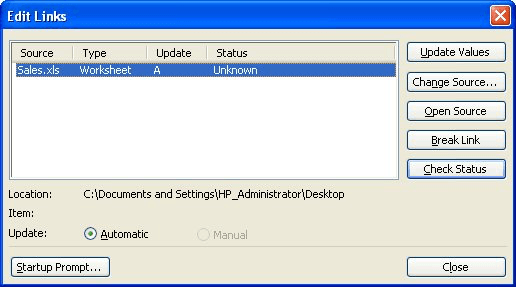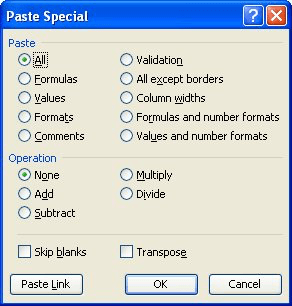Please Note: This article is written for users of the following Microsoft Excel versions: 97, 2000, 2002, and 2003. If you are using a later version (Excel 2007 or later), this tip may not work for you. For a version of this tip written specifically for later versions of Excel, click here: Replacing Links with Values.
Written by Allen Wyatt (last updated April 11, 2020)
This tip applies to Excel 97, 2000, 2002, and 2003
John has a large number of workbooks that have links in them and they are getting very large. He wonders if there is any way for Excel to convert the links to the data grabbed from those links so he can archive the old workbooks.
One thing to try is to open the workbooks that contain the links and then use Excel's tools to break the links. Make sure you keep a backup of your workbook (in case you mess things up) and follow these steps:

Figure 1. The Edit Links dialog box.
The result is that all the links are done away with, but the values last retrieved through the links remain in the workbook.
Another approach is to use Paste Special to "overwrite" your links. (This works well if you have a limited number of links in a worksheet.) Follow these steps:

Figure 2. The Paste Special dialog box.
If you have quite a few links in your workbook, then you will want to use a macro to do the link breaking. The following is an example of a simple macro to do the breaking:
Sub BreakLinks()
Dim aLinksArray As Variant
aLinksArray = ActiveWorkbook.LinkSources(Type:=xlLinkTypeExcelLinks)
Do Until IsEmpty(aLinksArray)
ActiveWorkbook.BreakLink Name:=aLinksArray(1), _
Type:=xlLinkTypeExcelLinks
aLinksArray = _
ActiveWorkbook.LinkSources(Type:=xlLinkTypeExcelLinks)
Loop
End Sub
It is important to remember, though, that links can be tricky. Links to other workbooks can be in formulas, names, charts, text boxes, and other objects, both visible and hidden, and in different combinations within formulas and those objects. Getting all the links and breaking them depends on the complexity of your workbook. If you have a complex workbook, then you may benefit by using the FindLink add-in created by Excel MVP Bill Manville. You can find it here:
http://www.manville.org.uk/software/findlink.htm
Note:
ExcelTips is your source for cost-effective Microsoft Excel training. This tip (7537) applies to Microsoft Excel 97, 2000, 2002, and 2003. You can find a version of this tip for the ribbon interface of Excel (Excel 2007 and later) here: Replacing Links with Values.

Dive Deep into Macros! Make Excel do things you thought were impossible, discover techniques you won't find anywhere else, and create powerful automated reports. Bill Jelen and Tracy Syrstad help you instantly visualize information to make it actionable. You’ll find step-by-step instructions, real-world case studies, and 50 workbooks packed with examples and solutions. Check out Microsoft Excel 2019 VBA and Macros today!
Excel allows you to easily link information from one workbook to another. If you want to get rid of links that may be ...
Discover MoreWhen you establish links between data on a target worksheet and data on a source worksheet, those links are typically ...
Discover MoreIf you have linked information in your worksheets, you may want a way you can easily change the targets to which those ...
Discover MoreFREE SERVICE: Get tips like this every week in ExcelTips, a free productivity newsletter. Enter your address and click "Subscribe."
There are currently no comments for this tip. (Be the first to leave your comment—just use the simple form above!)
Got a version of Excel that uses the menu interface (Excel 97, Excel 2000, Excel 2002, or Excel 2003)? This site is for you! If you use a later version of Excel, visit our ExcelTips site focusing on the ribbon interface.
FREE SERVICE: Get tips like this every week in ExcelTips, a free productivity newsletter. Enter your address and click "Subscribe."
Copyright © 2026 Sharon Parq Associates, Inc.
Comments